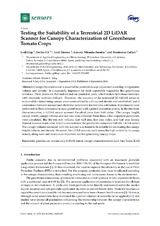Testing the Suitability of a Terrestrial 2D LiDAR Scanner for Canopy Characterization of Greenhouse Tomato Crops
Autor
Llop, Jordi
Gil Moya, Emilio
Llorens, Jordi
Miranda Fuentes, Antonio
Gallart, Montserrat
Editor
MDPIFecha
2016Materia
GreenhouseTomato crop
LiDAR sensor
Canopy characterization
Leaf Area Index (LAI)
METS:
Mostrar el registro METSPREMIS:
Mostrar el registro PREMISMetadatos
Mostrar el registro completo del ítemResumen
Canopy characterization is essential for pesticide dosage adjustment according to vegetation
volume and density. It is especially important for fresh exportable vegetables like greenhouse
tomatoes. These plants are thin and tall and are planted in pairs, which makes their characterization
with electronic methods difficult. Therefore, the accuracy of the terrestrial 2D LiDAR sensor is
evaluated for determining canopy parameters related to volume and density and established useful
correlations between manual and electronic parameters for leaf area estimation. Experiments were
performed in three commercial tomato greenhouses with a paired plantation system. In the electronic
characterization, a LiDAR sensor scanned the plant pairs from both sides. The canopy height,
canopy width, canopy volume, and leaf area were obtained. From these, other important parameters
were calculated, like the tree row volume, leaf wall area, leaf area index, and leaf area density.
Manual measurements were found to overestimate the parameters compared with the LiDAR sensor.
The canopy volume estimated with the scanner was found to be reliable for estimating the canopy
height, volume, and density. Moreover, the LiDAR scanner could assess the high variability in canopy
density along rows and hence is an important tool for generating canopy maps.

